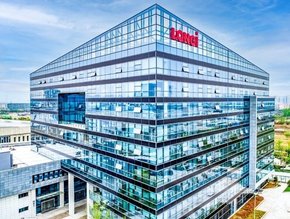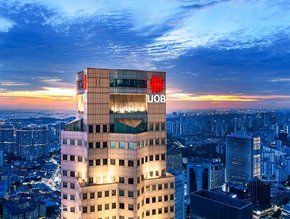How AI is ushering in the age of the augmented workforce

Fears around AI taking people’s jobs have been heavily reported, yet a new global study from IBM has found that 87% of executives believe employees are more likely to be augmented than replaced by generative AI in the future.
The reality is that people are an organisation’s core competitive advantage, even in a world where AI has become more pervasive.
“This era will be defined by the partnership between humans and AI,” says Matt Candy, Global Managing Partner, Generative AI at IBM Consulting.
Matt, who has more than 25 years of experience in consulting at PwC and IBM, and currently drives the genAI strategy, adoption and enablement of 160,000 consultants, tells Business Chief that AI is about a new way of working.
“We are living through something special, a significant inflection point not only for AI, but for the whole world. It will impact and provide huge opportunities for business, society and for each of us now and for generations to come.”
By 2030, global GDP will have grown by 14% – that’s the equivalent of US$15.7 trillion as a result of AI. Think about how many jobs that is and the follow-on impact on society and the economy.
“There is tremendous opportunity with genAI when it comes to reshaping the workforce,” says Matt.
“We know our clients are having to do more with less, and boosting employee productivity and enhancing the workforce experience is where AI can help define higher-value work, drive more innovation and lead to improved business outcomes.”
Based on a recent IBM Institute for Business Value study, CEOs ranked productivity as their highest priority and are increasingly looking to operational, technology and data leaders as strategic decision makers for solutions.
“As our former chairman and CEO Ginni Rometty reminds us, ‘we should never forget that the purpose of technology should be to augment humanity’.”
So how will this new partnership between humans and AI work? What will it mean for employees and employers? And how should leaders be preparing the workforce for AI?
Here, we discuss the future of work with Matt.
Matt, as AI pervades the workplace, should people be worried about losing their jobs?
Whilst some may worry about job elimination, the reality is that there is a disinflation in demographics and a decline in the size of the working age population. The global economy actually needs this increased productivity to maintain quality of life and drive GDP growth.
The World Economic Forum (WEF) predicts that automation will disrupt 85 million jobs globally between 2020 and 2025 – yet it will also create 97 million new job roles. This is a radical shift which is ushering in, what we at IBM are calling, the age of the augmented workforce – an era when human-machine partnerships boost productivity and deliver exponential business value.
This evolution, though, is widening the global skills gap.
The WEF predicts that almost half (44%) of all workers’ skills will be disrupted in the next five years. I believe that generative AI could push that figure even higher.
A recent IBM Institute for Business Value study on the augmented workforce found that four in five executives say generative AI will change employee roles and skills. Yet another IBM study, which looked at the impact of AI on CEO decision-making, found that only 28% of CEOs said they have assessed the potential impact of genAI on their current workforce. This leaves a notable gap.
While workers at all levels will feel the effects of generative AI, IBM’s study found that more than three in four executives said entry-level positions are already being impacted, compared to 22% who said the same for executive or senior management roles.
As AI continues to evolve, its effects will likely intensify across the board with no level or role immune to the impact.
But AI will augment far more employees that it will replace – with 87% of executives believing job roles are more likely to be augmented than automated.

So what will this mean for employees and the future of work?
AI has the potential to transform the employee experience.
We see generative AI as a technology that will augment human expertise, not replace – and certainly we see employees who embrace and use generative AI in their daily work and workflow will displace those employees who do not use it.
It ushers in a new era where human potential is less constrained by process silos, where human creativity is unleashed and the potential of every person on every team is amplified. It is an opportunity to fuel and fund innovation.
Consider the mid 70s and 80s when the ATM machine rolled out at scale, the reaction wasn’t necessarily one of awe or appreciation for convenience. People were concerned we were automating teller jobs. But as we now know, when tellers didn’t have to spend their days counting out cash, they were able to do more valuable tasks. This is the common explanation for why bank teller employment and salaries increased even as we “automated them out of work.”
We have seen numerous examples of AI successfully augmenting employee tasks, certainly when it comes to more manual and repetitive projects and speeding up the throughput of work.
One such case is with France’s Bouygues Telecom, a major B2B provider of mobile services, which partnered with IBM Consulting to automate the process of qualifying online sales leads. By using an AI app on the Bouygues Telecom website, the qualification call centre can automatically sort out irrelevant information, speeding lead generation for sales teams and dramatically reducing costs.
Within IBM, we too are completely reimagining our employee experiences by adopting an AI-first mindset and infusing NLP and AI into solutions our employees use.
For HR, 94% of all employee-HR interactions now happen through a natural language enabled interface without any human intervention embedded in tools like Slack. We’re doing this ourselves, at scale. I think of this as the headless enterprise – a set of tools and systems, available through a simple chat interface that meets your employees where they are – and masks any complexity of the underlying systems landscape and process silos.
Some of the most exciting outcomes of bringing humans and AI together are the possibilities to imagine and create personalised content, elevate the customer experience and empower employees and creatives to be more productive and strategic by transforming how decisions get made in organisations as well as improvements in efficiency of processes and workflows.
AI frees employees up to focus on higher value work and uses the productivity gains to create the fuel for new experiences, new revenue streams and new business models to drive competitive advantage.
What are the challenges to introducing AI quickly and efficiently across organisations?
In order for businesses to gain a competitive edge, augmenting the workforce for the age of AI is critical, today. However, there are some barriers to it being done quickly and efficiently.
Legal, compliance and security teams are all rightfully sounding the alarm about the business risks of using generative AI without responsible guidelines. Creativity thrives with a degree of constraint, and people can only experiment and build when they know the underlying models are responsible and trustworthy. Getting those guardrails and guidelines in place, allows people to start to experiment in an enterprise safe way.
Digital transformation brings challenges in all forms; moving to the cloud, automating workflows, and adopting AI means ensuring cybersecurity, IT, and data management issues must also be managed in tandem. As leaders tackle this intimidating to-do list, talent transformation – and augmenting the workforce – often gets bumped to the bottom.
To successfully leverage AI for an augmented workforce, businesses will need to adopt a multi-model, multi-cloud and open approach, using models that are safe for enterprise use and that are being trained on datasets that don’t open them up to IP infringement and other risks. From a consulting perspective, we’re working with our own IBM technology, but also across Microsoft, AWS, Salesforce, Adobe and other partners, helping clients leverage the right tool for the job, quickly and efficiently.

In augmenting the workforce, what are the main pitfalls?
Leaders are looking to simplify, streamline and eliminate processes in every corner of the enterprise by applying AI and automation. But productivity doesn’t happen with technology alone. The need to understand people and define processes must come first before applying the technology.
Enterprise businesses need to be strategic about change management –and a new kind of change management, that’s about cultivating new ways of working, shaping new job role responsibilities driving a cultural shift in the organisation and fostering trust. Without intentional workforce planning and design, the technology – and the business – won’t meet its potential.
Most importantly, getting to the people who are closest to the work and the process – they are in the best possible position to help enable the infusion of AI to drive efficiency improvements. Democratising the ability for all employees to access this type of AI capability to re-imagine how work gets done will be the most effective way to drive adoption rather than a top down approach.
How do leaders prepare for this new way of working? How important is reskilling in this?
To prepare employees for new applications of AI, business leaders need to put human skills at the centre of a workforce strategy.
As AI models take over mundane tasks, employees are being afforded more time to spend on the problem-solving and collaborative work that require these stronger people skills. The IBM augmented workforce study shows that time management and prioritisation, collaboration, and communications skills are leading the way as the most coveted. Skills that AI simply cannot replace.
Re-skilling and up-skilling in key behavioural skills and in technology are a critical focus, to benefit the enterprise as well as the individual employee and their long-term career goals.
Business leaders estimate that 40% of their workforce will need to reskill because of implementing AI and automation over the next three years. That translates to 1.4 billion of the 3.4 billion people in the global workforce, according to World Bank statistics.
Reskilling the workforce is critical as economic and market dynamics will continue to play a significant role affecting the value of, need for, and availability of workforce skills.
Leaders will need to focus on increasing the general technical acumen of the entire workforce. This doesn’t mean every employee will have to learn how to code – but most will have to familiarise themselves with new AI solutions. Companies will also need to think about how to move people who have been freed from routine work by AI into roles that are more fulfilling and impactful to the business.
Everybody needs to learn how to work with AI and these large language models. Prompt engineering will be a skill that all employees need to embrace in their daily lives – learning how to ask good and precise questions to get the answers you are after will be a really important future skillset.
People also need to understand the governance of AI – that it needs to be transparent and how to think about data that AI should and shouldn’t be using.
In this way, infusing AI across a company’s workflows will not only drive new insight and innovation, but also lead to a more satisfied and productive workforce.
What should leaders be doing as the first step in designing an augmented workforce?
No AI technology will magically change things without an enterprise-wide, human-centred approach to adopting AI. Leaders should be considering some of the following steps:
- Encourage a culture of curiosity, of innovation and of continuous learning. Provide support and resources for those who are apprehensive – ensure no one is left behind. Learn, experiment and try. Engage those closest to the process and the workflows to drive the ideas for AI.
- Meet employees where they are - the future of the enterprise is faceless and composable, where the needed back-end elements, data and tools are always available. The quickest way to see and understand the generative AI opportunity is to build and make something - be an AI value creator, not just an AI user. You won’t truly grasp what this new AI moment is all about until you experience it yourself.
- Take a long view on trust: develop cultural fluency in the organisation – embedding a culture of responsible AI & trust in all you do from the start. Every decision must have ethical considerations.






